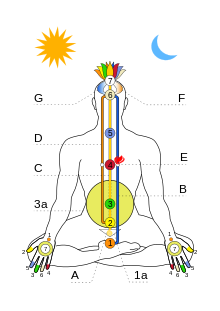A recent exercise we decided to do is taken from the Tibetan Buddhist tradition. While this is a common exercise I understand that each lama has his own way of doing things so if you come across this exercise from a different teacher then it might not be quite the same. I also do not currently have a direct Tibetan Buddhist lama that I am learning this from, but instead, I am hearing it from my friend who writes the Blue Flame Magic blog and who has written an article about this practice here on Blue Flame Magic so there might be some errors in transmitting the practice to someone who is not saturated in Tibetan Buddhist Vajrayana practice and the associated practices, ie me. In the process of me learning I could make some assumptions because of my own ignorance of certain parts of the practice as anyone would who wasn’t raised in those religious practices.
The technique is known in Tibetan as དགུ་རླུང་བསངས་ gulung sang.
9 purifying breath is essentially what it says on the tin. 9 inhalations and exhalations which are designed to purify the subtle body.
A prerequisite of this practice is that the practitioner be capable of performing basic energy work. For the purpose of doing this practice, we switch to the model that the subtle body can be mapped a bit like the image below. You don’t need to worry about any interaction between the channels you are working with and the energy centres/chakras. For the purpose of this ritual, those chakras are a separate system.

You can use the following checklist for maintaining a suitable meditative position, in this exercise we are using a mudra where the thumb is touched to the base of the ring finger as well as the following checklist. The checklist is referred to as Vairochana’s seven-point posture.
- Sit down crossing your legs
- One top of your legs / knees rest your hands
- Above this your spine is erect and straight up
- At the top of your spine, spread out your shoulder blades like the wings of a vulture
- Above your shoulders your neck should hold your head slightly lowered
- Above your neck, your mouth should have your tongue touched to the upper palate gently
- Above your mouth, your eyes should gaze gently beyond the nose
Begin by taking the right-hand maintaining the mudra and using the ring finger to press closed the right nostril. Then through the left nostril inhale pure white energy which enters the energy channel behind the left eye, goes over the top of the skull and down the channel on the left side and enters the central channel at the base of the spine. Then quickly swap hands so the opposite nostril is closed. That energy from the central channel must then be expelled from the centre channel to the right channel up and over the head and out the right nostril taking as much dirty and stagnant energy as possible with it.
The dirty / stagnant energy can be dispersed thinly to nothing or passed into the earth.
Repeat until you have done this 3 times on one side. Then do it three times on the other side.
Then place your hands palm-up on your thighs pressing down with the back of the hand. Inhale with both nostrils over the skull down the channels to the base and into the centre channel and exhale the energy dirt through the central channel.
Initial Experience and Preconceptions
The exercise is very similar to the common pranayama exercise called Anulom Vilom Pranayma. This means with the grain and against the grain breath exercise. There is a similar method of closing nostrils and its use is similar. It might even have similar roots to 9 breaths. So we need to put aside all preconceptions and treat this as an entirely different exercise so the preconceptions don’t colour the results.
The seven-point posture of Vairochana is good because it makes sure I open the shoulder blades which are generally very tense and so it forces relaxation which is extremely helpful to focus on more subtle energies and having a checklist is always helpful to me. Also, the list is bottom to top so it’s easier to remember its content.
There is a certain lack of flexibility in my hands, which means, reaching the base of the ring finger is not easy or comfortable. The tension required to maintain that is distracting from the practice. After the first practice, I found placing the thumb at the top of the proximal phalange was preferable.
The exercise took a few tries to make sure we had covered all of its finer points: such as going over the top of the head and making sure the inhaled energy was bright and pure. Once done a couple of times this came naturally.
Having this reduced to 9 breaths is really good because it is a short exercise and you can assume it is complete when you are finished. Similar practices such as the aforementioned Anulom Vilom Pranayama don’t normally come with an end so you are often in a state of “could my energy be made cleaner” which generates doubt about the amount of success achieved. Having an end to the practice seems really beneficial.
Early Experiences
Timing subtle movements with the breath slowed down my breathing. I found myself forced to worry about breathing because I was breathing too slowly and I was too busy trying to complete a subtle movement to breathe. This made my brain naturally force me to think about breathing to survive. This was distracting from the process. Not worrying about ensuring the subtle movement was so complete allowed me to do it normally and putting in a normal breath in between each cleansing breath helped.
Generally, I feel lighter. My energy is cleaner and more vital which is similar to when I was doing daily pranayama exercises, but this took a lot less time.
Although I exercise daily and have done for months, going from hypertension to pre-hypertension on my blood pressure measurements happened to coincide with day three of this practice.
